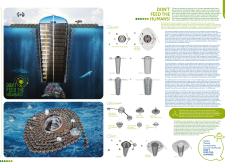5 key facts about this project
The design features a floating complex located within deep-sea environments, tailored to meet the unique challenges presented by the ocean. The aim is to represent the complexities of humanity, showcasing both strengths and weaknesses. This structure adapts to the surrounding marine context, allowing for growth and evolution while emphasizing a commitment to sustainability.
Design Concept
The main building is capable of adjusting to various ocean depths. It allows for vertical expansion through additional rings that can be added after initial construction. This flexibility not only addresses structural demands but also enables a continuous architectural narrative. Organized into three sections—bright, blur, and dark—the design symbolizes different aspects of human experience, with divisions that highlight inherent contradictions.
Structural Elements
Resembling a sectioned cone, the main building is supported by a central steel mast. This mast serves as the focal point for visitor observation platforms. Visitors can engage with displays featuring human specimens, prompting exploration of existence and identity. Every three floors, access walkways facilitate movement, offering an engaging experience as individuals navigate through the various stories presented by the architecture.
Service Islands
Surrounding the primary structure, secondary service islands provide key support functions. These islands feature a solar panel power station, a digital communication port, and a water desalinization unit. These elements work together to enhance sustainability and self-sufficiency. The design of these islands allows for adaptability, ensuring that they can evolve as new technologies emerge, reinforcing their importance within the maritime environment.
Sustainable Materials and Mechanisms
A notable aspect of the floating complex is the use of net balls filled with plastic and other debris to achieve stability and buoyancy. This solution allows the structure to remain effective above the water’s surface while addressing concerns related to ocean pollution. The integration of discarded materials into the design emphasizes a connection with environmental responsibility.
The main building incorporates spaces for human remains, DNA deposits, and personal artifacts, layered within the architecture. This arrangement encourages visitors to reflect on life, memory, and legacy as they engage with the various elements of the structure.



















































